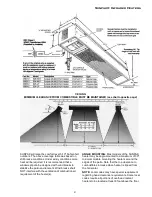
Sunpak® Infrared Heaters
3
Heater Layout and Design
Sunpak
®
heaters were specifically designed to provide
heated comfort in an outdoor environment. They have
been used on outdoor patios across the United States and
Canada for over 20 years. When properly integrated into a
patio design, Sunpak
®
heaters generally increase the
comfort level 5 to 10 degrees Fahrenheit outdoors. The
heating effectiveness will depend on air temperature, wind
velocity and other factors. Whenever possible local
Sunpak
®
installations should be reviewed to determine the
effectiveness for regional environments.
The environments in which Sunpak
®
heaters are
utilized vary greatly. As an outdoor rated heater it has
passed basic wind and rain tests. This does not mean the
heater cannot be damaged by the environment or when
operated in very windy conditions. For this reason it is
strongly suggested that heaters be inspected and if
necessary repaired annually or before each heating
season.
The variable environments in which Sunpak
®
heaters
are applied means that these general guidelines are
general by necessity and may need to be refined for local
conditions. These guidelines are to be used in
combination with the installation instructions.
Patio Design Consideration
Heater placement is critical for effective and efficient
patio heating. If heaters are placed too close together or
mounted too low, people become uncomfortable. If
heaters are placed too far apart on a breezy, wind-swept
patio the patio may never get warm.
Sunpak
®
heaters work best if they are placed in areas
of the greatest heat loss, such as the open side of a semi-
protected patio area. The Sunpak
®
heater may be
mounted at up to a 30 degree angle or face down. Note
that the top clearances required from combustible material
increases when heaters are at any angle. The heater must
always be horizontal to the floor.
WARNING
Fire and Explosion
Proper clearance for combustible materials must be
maintained. See installation section of this manual
for required clearances for different model and
mounting options.
Sunpak heaters may be laid out in a number of
configurations depending on the structural constraints of
the patio and heating requirements. One approach is to
face heaters straight down over the table and seating
areas. Another approach is to locate heaters to the side
and to angle them inward. A third approach is to cluster
the heaters in the center of the patio and angle heaters
outward. It all depends on the needs of a particular patio.
Breezy conditions must be considered when heating any
patio. Windbreaks can be extremely effective in increasing
comfort and reducing heating costs. Windbreaks must be
designed in such a way to allow for the necessary fresh air
and ventilation for proper heater operation (see ventilation
of installation section).
WARNING
Asphyxia / Carbon Monoxide
Heater requires adequate combustion air and
ventilation in order to operate safely. Improper
ventilation can generate carbon monoxide or
other harmful gases that could result in death
or breathing difficulties. Small or enclosed
patios may not be appropriate to for this type
of heater.
Sunpak heaters must always be operated in a location
that allows uniform air pressure around the heater. If only
part of the heater is located in a wind protected zone
damage to the heater may occur. Time should be taken to
observe how the wind will affect the heaters under local
conditions.
Caution
Damage to Heater
Failure to operate heater in a uniform air
pressurize environment or under erratic wind
conditions can cause over-heating of controls,
and damage to the front grill and burner.
Temperature Control
A thermostat can be incorporated into the electrical
circuit; however this may not be the best means of
temperature control. Because the infrared heat warms
people and objects, when used outdoors the heater may
not increase the air temperature and thus the thermostat is
never satisfied.
When multiple heaters are used it is suggested that they
be put on individual switches to provide flexibility in
heating. Typically all the heaters would be turned on to
heat a cold patio, and then heaters would be turned off
selectively as people settle in. A timer or master switch
may be convenient to ensure the heaters are not turned on
when the patio is not in use.
Содержание Sunpak S25
Страница 5: ...Sunpak Infrared Heaters 5 ...
Страница 7: ...Sunpak Infrared Heaters 7 ...
Страница 11: ...Sunpak Infrared Heaters 11 ...
Страница 12: ...Sunpak Infrared Heaters 12 ...
Страница 13: ...Sunpak Infrared Heaters 13 ...
Страница 14: ...Sunpak Infrared Heaters 14 ...


































